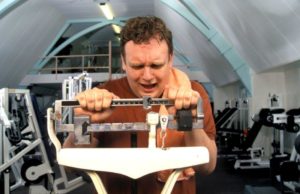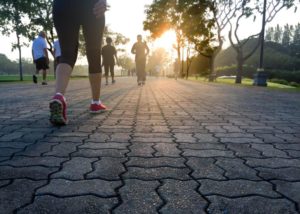Weight Management/Weight Loss
High-Intensity Interval Training for Fat Loss
Two recent studies reveal that high-intensity interval training has the ability to produce high-impact fitness gains in a short time frame.
Fit and Fat?
Weight loss may be the number-one goal for your clients, and if pounds don’t melt away quickly, some people may get discouraged and quit. New research strengthens the case that your program is still helping them obtain positive health outcomes, which is motivation to keep striving. In other words: Being fit benefits health even among people with severe obesity.
Behavior Change: What the Research Tells Us
Behavior change psychology has immense value to personal trainers and other fitness pros looking to motivate their clients.
Exercise Doesn’t Have To Be Strenuous To Be Effective
We know that replacing sedentary behavior with physical activity yields numerous benefits. And while high-intensity models are touted as a way to fast-track success, a new study out of Sweden says it’s not necessary to go all-out in order to boost health.
Location Is Everything When It Comes to BMI
The results are in: According to a new study, people who live within close proximity to a gym or activity center weigh less than those who don’t. Access to fast-food restaurants may also affect weight, say the study’s authors.
Selfies, Weight Loss and Virtual Support
Social media and selfie photos can play a positive role in helping people achieve weightloss goals, according to a study published in the Journal of Interactive Marketing in 2017.
Fitter Kids Have More Brain Gray Matter
While much research has pointed to a relationship between kids’ fitness and academic performance, we now have a new piece of the puzzle: A recent study found that aerobic fitness and speed–agility levels among overweight and obese children aged 8–11 were independently associated with more gray matter in parts of the brain related to better academic performance.
The Federal Government Keeps Making Nutrition Headlines
The current administration appears determined to weaken federal nutrition policy:
Face the Fats
For years, fat was demonized as dietary “Public Enemy Number One.” Despite the essential roles it plays in the body, including temperature regulation, hormone production and protection of organs, we were told it was also responsible for weight gain and a host of health woes. As a result, the public shied away from the macronutrient and instead stocked their kitchens with skim milk, fat-free snacks and low-fat dressings. This approach backfired spectacularly.
MyPlate Goes Seasonal
Looking for new nutrition tools and resources to share with clients? MyPlate has launched seasonal resources for nutrition and health professionals to share with clients. Jump into spring with gardening resources and ideas for using homegrown herbs in cooking, and sample Earth Day activities, farmers’ market resources, and tips for prepping potlucks and parties.
Learn more at choosemyplate.gov/seasonal.
Understanding Set-Point Weight
Humans are hardwired to resist dietary restrictions. Science bears this out: In the absence of an ongoing weight maintenance program, half of the people who lose 10% or more of body weight gain it all back within 5 years or so (Montesi et al. 2016).
On This Day in Fitness History
In February 2009, the American College of Sports Medicine, responding to mounting research evidence, updated its 2001 position stand on how much physical activity is needed to lose weight and not regain it.
Strength Training and Type 2 Diabetes
A regular exercise program can help people with type 2 diabetes to manage blood sugar levels and maintain or improve fitness levels and overall health.
Combined Training for Fitness and Weight Loss Clients
In today’s marketplace, knowing how to offer combined training is a must-have skill. People want it all—cardiovascular, strength and flexibility training—in just 50 minutes.
Taking the Right Step—Walking Research for the Ages
Have you ever heard clients say that “walking doesn’t count” as exercise? The truth is that walking can be a valuable part of your clients’ wellness routines—but how those steps fit into a whole program may depend on age. Two different studies offer valuable feedback on the benefits of walking through a workout.
STUDY #1: When Walking and Weight Loss Are in Step
Lose Weight, Save Money
A new report from Johns Hopkins Bloomberg School of Public Health suggests
that people who are overweight or obese could potentially trade weight for cash.
Authors of the report produced a model linking body mass index, health outcomes and associated costs at various points in an adult’s life. For example, for a 40-year-old, having obesity (vs. normal weight) adds $15,024 in lifetime third-party payer costs, $16,400 in lifetime productivity losses and $31,447 in societal costs. For a person of that age, being overweight (vs.
Some Cancers Are a Weighty Issue
About 40% of cancer cases are related to overweight and obesity, according to a new report from the Centers for Disease Control and Prevention.
Get Up, Stand Up—For Your Health
We know that sitting long hours is a health hazard that can lead to early death. What’s been unclear is whether frequent breaks in sit time can reduce that risk even if total sit time remains the same. Researchers from Columbia University Medical Center looked into that question.
Weight Disparities in Children Worldwide
When it comes to childhood health, lots of emphasis is placed on the risks of being overweight or obese—and an estimated 124 million kids worldwide were in those weight categories in 2016, a tenfold increase since 1975. While this is of great concern, a new study has found that in the same year, 192 million boys and girls were moderately or severely underweight. The researchers believe that family income levels may play a role in a child’s weight.
New Way to Calculate Childhood Obesity
Over the years, experts have questioned the accuracy of body mass index scores, known as BMI “z-scores,” for estimating body fat percentages in kids (the z is specific to younger age groups and requires complicated calculations to get results). The criticism is that adolescent weight doesn’t scale with height, which can produce faulty data. Now, researchers claim to have discovered a new, more accurate formula for measuring body fat in kids aged 8–17.



















